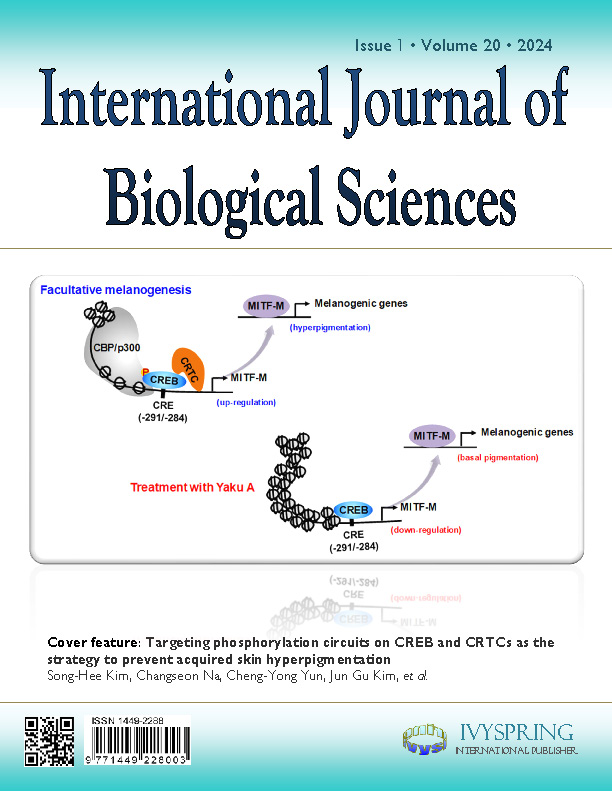在小鼠急性肺损伤过程中,中性粒细胞胞外捕获物通过 cGAS-STING 通路触发肺泡上皮细胞坏死
IF 8.2
2区 生物学
Q1 BIOCHEMISTRY & MOLECULAR BIOLOGY
引用次数: 0
摘要
肺泡上皮细胞(AECs)发生坏死而大面积脱落是急性肺损伤(ALI)的一个重要机制,但其诱发机制仍有待深入研究。中性粒细胞胞外捕获物(NET)在 ALI 中发挥着重要作用。然而,NETs 对 AECs 死亡的影响尚未明确。我们的研究发现,气管内灌注 NETs 会破坏肺组织结构,这表明 NETs 可诱发小鼠 ALI。此外,我们还观察到,NETs 在体内和体外均可诱发 AECs 坏死。经 NETs 处理后,MLE12 细胞中 RIPK3 和 MLKL 的磷酸化水平升高(P < 0.05)。从机制上看,AECs通过内吞摄取的NETs激活了cGAS-STING通路,并引发了AECs坏死。经NETs处理的MLE12细胞中cGAS、STING、TBK1和IRF3的表达均有所增加(P < 0.05)。此外,cGAS 抑制剂 RU.521 可抑制 NETs 触发的 AECs 坏死,减轻 NETs 对小鼠肺部的损伤。总之,我们的研究表明,AECs 通过内吞摄取的 NETs 可激活 cGAS-STING 通路并触发 AECs 坏死,从而促进小鼠的 ALI。我们的研究结果表明,靶向 AECs 中的 NETs/cGAS-STING/necroptosis 通路是治疗 ALI 的有效策略。本文章由计算机程序翻译,如有差异,请以英文原文为准。
Neutrophil extracellular traps trigger alveolar epithelial cell necroptosis through the cGAS-STING pathway during acute lung injury in mice
Extensive loss of alveolar epithelial cells (AECs) undergoing necroptosis is a crucial mechanism of acute lung injury (ALI), but its triggering mechanism needs to be thoroughly investigated. Neutrophil extracellular traps (NETs) play a significant role in ALI. However, the effect of NETs on AECs' death has not been clarified. Our study found that intratracheal instillation of NETs disrupted lung tissue structure, suggesting that NETs could induce ALI in mice. Moreover, we observed that NETs could trigger necroptosis of AECs in vivo and in vitro. The phosphorylation levels of RIPK3 and MLKL were increased in MLE12 cells after NETs treatment (P < 0.05). Mechanistically, NETs taken up by AECs through endocytosis activated the cGAS-STING pathway and triggered AECs necroptosis. The expression of cGAS, STING, TBK1 and IRF3 were increased in MLE12 cells treated with NETs (P < 0.05). Furthermore, the cGAS inhibitor RU.521 inhibited NETs-triggered AECs necroptosis and alleviated the pulmonary damage induced by NETs in mice. In conclusion, our study demonstrates that NETs taken up by AECs via endocytosis can activate the cGAS-STING pathway and trigger AECs necroptosis to promote ALI in mice. Our findings indicate that targeting the NETs/cGAS-STING/necroptosis pathway in AECs is an effective strategy for treating ALI.
求助全文
通过发布文献求助,成功后即可免费获取论文全文。
去求助
来源期刊

International Journal of Biological Sciences
生物-生化与分子生物学
CiteScore
16.90
自引率
1.10%
发文量
413
审稿时长
1 months
期刊介绍:
The International Journal of Biological Sciences is a peer-reviewed, open-access scientific journal published by Ivyspring International Publisher. It dedicates itself to publishing original articles, reviews, and short research communications across all domains of biological sciences.
 求助内容:
求助内容: 应助结果提醒方式:
应助结果提醒方式:


